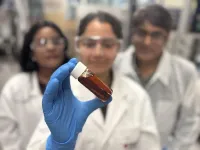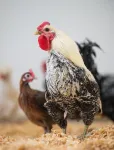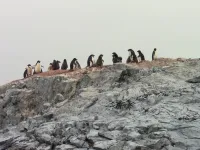(Press-News.org) UNDER EMBARGO UNTIL 00:01 BST THURSDAY 10 APRIL / 19:01 ET WEDNESDAY 9 APRIL 2025
For the first time, a study led by University of Oxford researchers has ‘listened in’ to the fascinating courtship displays of Fiddler crabs using geophones. The findings, published today in the Journal of Experimental Biology, provide new insights into how the animals communicate effectively on the noisy seashore.
For male fiddler crabs, vibrational signals are a crucial part of their courtship routines – produced by drumming the ground using their oversized claw, or hitting the floor with their shells. But up to now, it has been unclear how effectively these signals convey information in the sonically chaotic and competitive intertidal regions where fiddler crabs are found.
To investigate this, researchers from the University of Oxford’s Animal Vibration Lab assessed the courtship behaviour of the European fiddler crab (Afruca tangeri), which occupies the Southern mudflats of the Iberian Peninsula. For the first time, their novel approach recorded the male crab’s behaviour using both GoPro cameras and geophones, which precisely record acoustic vibrations. A key question was how seismic signals are affected by the signaller’s size – and therefore how ‘honestly’ they convey information about the male’s fitness as a mate.
The researchers observed that the male crabs carried out a repetitive, four-step courtship routine: starting with subtly waving their oversized claw, followed by sequential waving and body drops to produce a vibrational signal, then simultaneous motions, and finally an underground drumming display if the female approaches the burrow. At each step, the seismic energy intensifies.
By measuring over 8000 percussive seismic signal recordings, the researchers demonstrated that the morphology of the male was the critical factor in determining the signal features. In particular, males with larger claws produced higher-energy seismic signals, with higher amplitude drumming spikes. This appears to prevent the male from being dishonest about their size, enabling females to assess male quality and claw size from afar.
Lead author of the study Tom Mulder (Department of Biology, University of Oxford) said: "It appears as though the males cannot, or do not, lie about their physical size. Females can rely on the loudness of seismic signals to honestly assess a potential mate’s quality, all without needing to see him."
Furthermore, the researchers found that whilst the frequency of the vibrations remained constant, the length, rhythm, and loudness of the signals all varied depending on the courtship behaviour. This meant it was possible to distinguish different behaviours (e.g. body drops vs underground drumming) based on seismic recordings alone. Indeed, the team trained a machine learning programme to automatically classify behaviours with up to 70% accuracy. This opens up the possibility of using machine learning to automatically detect the presence and behaviours of animals based on material-bound vibrations for remote monitoring - for example, endangered animals in the African savannah, lame livestock, or insect pests on agricultural crops.
Percussive rather than vocal seismic communication tools are advantageous in the landscapes that these fiddler crabs call home and changing the loudness and repetition rate of the signals, although simple, are an effective means for small animals to communicate in these noisy environments.
Corresponding author Dr Beth Mortimer also of the Department of Biology concluded: “Larger claws have the advantage of overcoming seismic noise so that they can signal to females that are further away and females will show more interest in them. However, the advantages are only observed for the percussive signals such as drumming and fortunately for smaller clawed crabs, these are only part of the courtship routine.”
Notes to editors
The paper ‘Constraints on percussive seismic signals in a noisy environment by European fiddler crabs, Afruca tangeri’ will be published in Journal of Experimental Biology. It will be available online at 00:01 BST Thursday 10 April / 19:01 ET Wednesday 9 April 2025 at: https://doi.org/10.1242/jeb.249323
Interviews with Tom Mulder and Beth Mortimer are available on request: Tom Mulder: tom.mulder@sjc.ox.ac.uk; Beth Mortimer: beth.mortimer@biology.ox.ac.uk
About the University of Oxford
Oxford University has been placed number 1 in the Times Higher Education World University Rankings for the ninth year running, and number 3 in the QS World Rankings 2024. At the heart of this success are the twin-pillars of our ground-breaking research and innovation and our distinctive educational offer.
Oxford is world-famous for research and teaching excellence and home to some of the most talented people from across the globe. Our work helps the lives of millions, solving real-world problems through a huge network of partnerships and collaborations. The breadth and interdisciplinary nature of our research alongside our personalised approach to teaching sparks imaginative and inventive insights and solutions.
Through its research commercialisation arm, Oxford University Innovation, Oxford is the highest university patent filer in the UK and is ranked first in the UK for university spinouts, having created more than 300 new companies since 1988. Over a third of these companies have been created in the past five years. The university is a catalyst for prosperity in Oxfordshire and the United Kingdom, contributing £15.7 billion to the UK economy in 2018/19, and supports more than 28,000 full time jobs.
The Department of Biology is a University of Oxford department within the Maths, Physical, and Life Sciences Division. It utilises academic strength in a broad range of bioscience disciplines to tackle global challenges such as food security, biodiversity loss, climate change and global pandemics. It also helps to train and equip the biologists of the future through holistic undergraduate and graduate courses. For more information visit www.biology.ox.ac.uk.
END
New research to be presented at this year’s European Congress on Obesity (ECO 2025, Malaga, Spain, 11-14 May) shows that patients using GLP-1 or combined GLP-1 / GIP receptor agonist therapy for weight loss experienced minimal lean muscle mass loss as they lost weight across 6 months of treatment. The study is by Dr Dinabel Peralta-Reich, Donald and Barbara Zucker School of Medicine at Hofstra/Northwell; Lenox Hill Hospital, Northwell Health, New York City, NY, USA, and Dr Alexandra Filingeri, New York Weight Wellness Medicine, New York City, NY, USA, and colleagues.
GLP-1 (glucagon-like peptide-1) receptor agonists, ...
Australian technology developed at RMIT University could enable more sustainable and cheaper production of bio-oils to replace petroleum-based products in electronic, construction and automotive applications.
The technology, known as PYROCOTM, uses high temperatures without oxygen to convert treated sewage (biosolids) into a carbon-rich product called biochar, which can act as a catalyst to produce phenol-rich bio-oil.
PYROCOTM has been developed by RMIT in collaboration with South East Water, Intelligent Water Networks and other water authorities over several years and is now being applied to several exciting circular economy applications.
The RMIT team's latest research in collaboration ...
An international team of researchers led by Professor Huaijun Zhou from the UC Davis Department of Animal Science has created the first-ever detailed map of how genes are regulated in chickens — a breakthrough that could help scientists breed birds that are more resistant to diseases like avian influenza.
The study, published April 8 in Nature Genetics, brings together a massive amount of genetic and epigenetic data of more than 100 chicken breeds from around the world. The team, which ...
What: In a massive scientific effort funded by the National Institutes of Health (NIH), hundreds of researchers have helped to map the connections between hundreds of thousands of neurons in the mouse brain and then overlayed their firing patterns in response to visual stimuli. This breakthrough is a critical piece of foundational science to build toward understanding how our brains process visual information to reconstruct the images we see every day.
Information processing in the human brain occurs ...
In 1962, when environmentalist and author Rachel Carson penned Silent Spring, alerting the world to the dangers of the pesticide DDT, it was the reproductive threat to birds – the bald eagle in particular – that spurred people to action.
Six decades later, Rutgers University–New Brunswick researchers are taking the measure of another global environmental pollutant by drawing parallels to the crisis Carson identified. This time, the pollutant is mercury, and the sentinels are penguins living in the farthest reaches of the Antarctic Peninsula.
“With mercury, there’s an analogy to DDT,” said John Reinfelder, a professor in the Department of Environmental Sciences ...
Before humans can colonize the moon or Mars, scientists and engineers must first develop techniques for building permanent structures and pressurized habitats in harsh, thin-atmosphere and low-gravity environments.
Dr. Wei Li, an assistant professor of mechanical engineering in the Erik Jonsson School of Engineering and Computer Science at The University of Texas at Dallas, is developing a virtual lunar welding platform to troubleshoot assembling large structures in such conditions.
“As we try to return to the ...
Higher firearm violence in neighborhoods is linked to lower rates of people going to the dentist and higher rates of total tooth loss, known as edentulism, according to Rutgers researchers.
Their study, published in the American Journal of Preventive Medicine, used data from the Centers for Disease Control and Prevention for dental care utilization and complete loss of teeth and data from the American Violence Project for firearm violence incidents. The researchers examined 20,332 census tracts within the 100 largest cities in the United States from 2014 to ...
A new approach to streaming technology may significantly improve how users experience virtual reality and augmented reality environments, according to a study from NYU Tandon School of Engineering.
The research — presented in a paper at the 16th ACM Multimedia Systems Conference on April 1, 2025 — describes a method for directly predicting visible content in immersive 3D environments, potentially reducing bandwidth requirements by up to 7-fold while maintaining visual quality.
The technology is being applied in an ongoing NYU Tandon National Science Foundation-funded project to bring point cloud video to dance education, making ...
EMBARGOED FOR RELEASE UNTIL 4:00 P.M. ET, WEDNESDAY, APRIL 9, 2025
MINNEAPOLIS — Heavy drinkers who have eight or more alcoholic drinks per week have an increased risk of brain lesions called hyaline arteriolosclerosis, signs of brain injury that are associated with memory and thinking problems, according to a study published on April 9, 2025, online in Neurology®, the medical journal of the American Academy of Neurology. The study does not prove that heavy drinking causes brain injury; it only shows an association.
Hyaline arteriolosclerosis is a condition that ...
EMBARGOED FOR RELEASE UNTIL 4:00 P.M. ET, WEDNESDAY, APRIL 9, 2025
MINNEAPOLIS — While some studies have suggested that having a mother with Alzheimer’s disease may put you more at risk of developing the disease, a new study finds that having a father with the disease may be tied to a greater spread of the tau protein in the brain that is a sign of the disease, according to a study published on April 9, 2025, online in Neurology®, the medical journal of the American Academy of Neurology. The study does not prove that having a father with Alzheimer’s results in these brain changes; it only shows an association.
The study also showed ...






